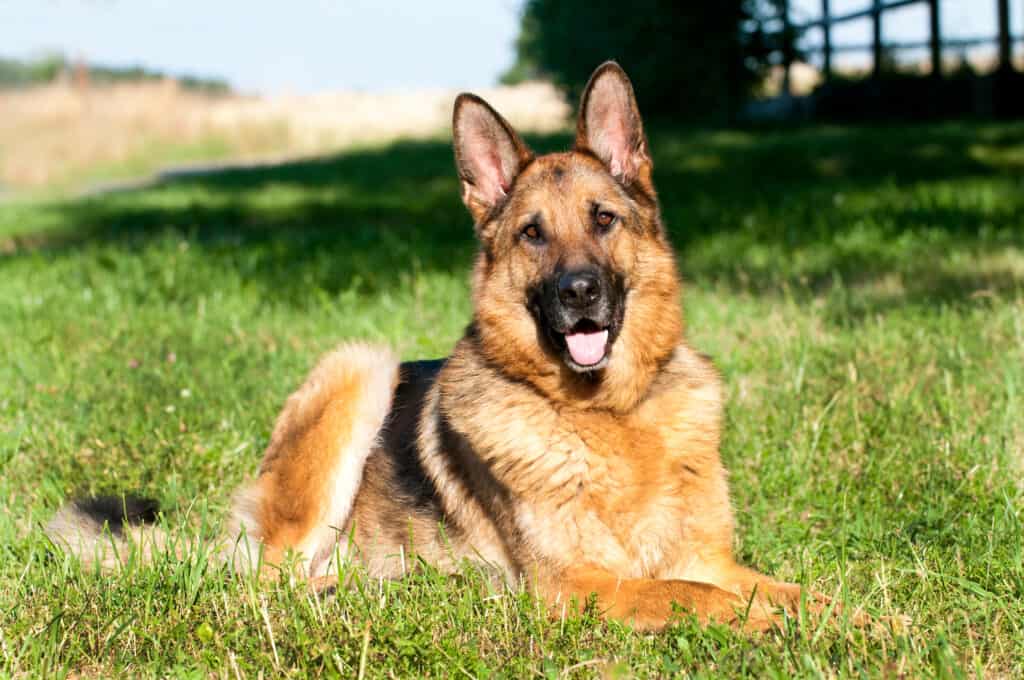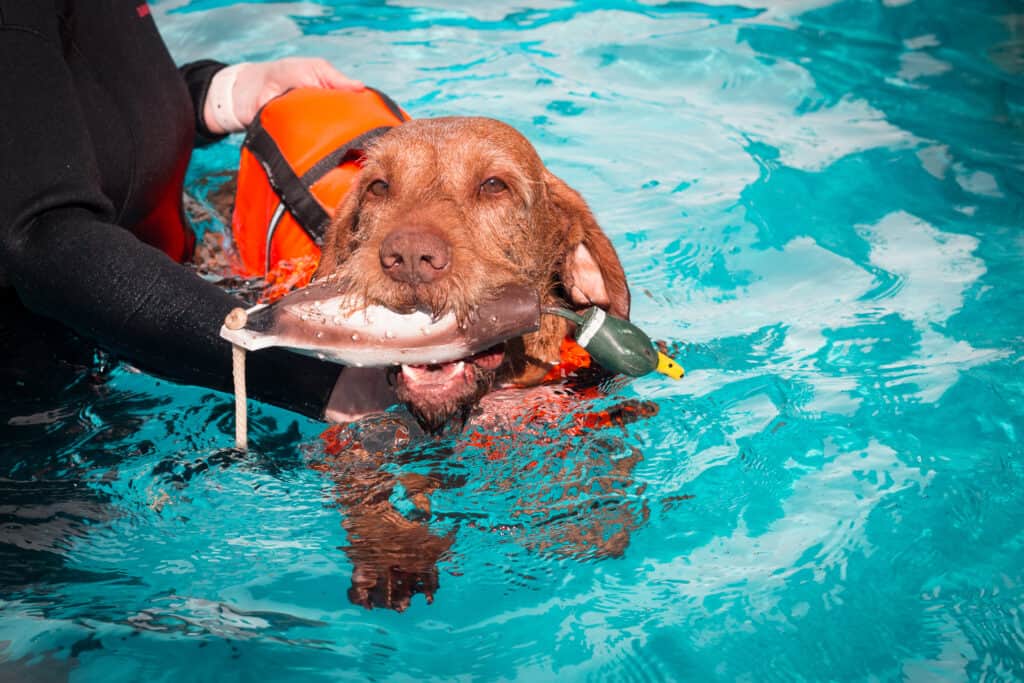Canine hip dysplasia is a distressing condition that requires veterinary attention and lots of support from a loving owner. Dogs with hip dysplasia vary in size and breed, but the symptoms are common across the canine world. Here are the signs of hip dysplasia in dogs you need to watch out for.
What Is Hip Dysplasia in Dogs?
Before we examine signs of hip dysplasia in dogs, it’s worth finding out exactly what it is because this will help us understand the vaguer signs that indicate your dog has hip dysplasia.
Hip dysplasia is a skeletal condition, and it’s sadly common. You’ll have guessed from the name that it affects a dog’s hips, but elbow dysplasia is also common and has the same symptoms.
A dog’s hip joint functions like a ball in a socket. In healthy dogs, the hip ball movement in the socket is smooth. It fits properly and moves around with ease. In dogs with hip dysplasia, the hip ball and socket have not developed properly, so it doesn’t fit well.
This means their bones grind against each other instead of running smoothly. Constant rubbing and grinding of bones lead to joint deterioration. Over time, this leads to severe pain and restricted movement as the joint becomes immovable or unstable.

Hip dysplasia occurs when a dog’s hip ball and socket do not fit together correctly, causing the bones to grind against each other.
©Catherine Avilez/Shutterstock.com
Causes of Hip Dysplasia
Hip dysplasia is caused by genetics. Most dogs inherit it from one or both parents. Hip dysplasia most often occurs in medium to large dogs, but it can occur in toy breeds too. The most common dog breeds that inherit hip dysplasia includes German shepherds, golden retrievers, labradors, Newfoundlands, Rottweilers, and Great Danes.
Overweight dogs and excessive growth rates magnify inherited hip dysplasia, make it worse, and shorten the dog’s lifespan, so extra special care is required to ensure your pooch has a long and happy life.

German shepherds are one of the most common dog breeds that inherit hip dysplasia.
©Dora Zett/Shutterstock.com
Dog Hip Dysplasia Signs
Symptoms usually start in puppyhood and get worse as the pup grows into an adult. In some cases, hip dysplasia presents itself as a problem in older dogs as they develop arthritis.
Here are 12 signs of hip dysplasia in dogs.

If your dog stops showing interest in things that used to excite them, they may be experiencing joint pain.
©Augusten Burroughs/Shutterstock.com
Bunny Hopping
One very obvious sign of hip dysplasia is bunny hopping. This is running with the back legs moving together in a hopping motion instead of each leg working independently. It’s a sign that the joints are not running smoothly.
Limping
Some dogs develop more pain on one side of their body, and this leads to limping or favoring the less painful side. Limping isn’t always obvious, so it’s worth watching your dog on a regular basis to ensure they are using all four paws equally.
Stiffness
We all get stiff if we’ve been sitting or lying around for a while, but it should wear off quickly. Dogs with hip dysplasia struggle to get moving, especially in the morning or after a walk. They may find it hard to stand up and/or lie down or get comfortable.
Hip dysplasia reduces the amount of movement the hips can make. You may notice your dog stretching out but unable to reach his full motion capacity.
Wobbly Walking
Swaying or wobbly walking is a sure sign of hip dysplasia because the joints are not stable enough or hurt too much to walk briskly and evenly. Dogs with a swaying back end are likely suffering from hip dysplasia.
Inability to Climb Stairs
If your dog has painful hips, he will not want or be able to climb stairs. Other similar activities, such as jumping into the car or bath, are similarly affected as they lose power in their back end.
Skinny Hips
Skinny hips, in comparison to their front end, indicate skinny, weak muscles in the hips and back legs. Your dog’s front shoulder muscles may increase in mass as they compensate for the weaker back muscles.
Don’t Want to Go Walkies
If there’s something dogs love (other than food), it’s the chance to go for a walk and explore the neighborhood with a twitching nose. Dogs that show no interest in walkies may be suffering from hip dysplasia pain.
‘Bad’ Behavior
As well as avoiding walkies, a dog suffering from painful hip dysplasia may disobey commands that cause them discomfort, such as jumping or the begging position.
Whining or Shrieking
Watching your dog move with difficulty is a good indicator of hip dysplasia, but your dog may make it more obvious with yaps, groans, shrieks, or whining. This is a reaction to pain.
Hot Hips
If your dog has hip dysplasia, his hip joints may feel hot. This is a result of swelling around the joint. Your dog might not want you to touch them if it’s painful, so take care.
Grinding Noises
You may hear grinding noises in your dog’s hips as they attempt to move. This is the sound of bone on bone, which is painful for them.
Overall Lethargy and Depression
Pain is draining, and dogs are prone to depression just as we are. Constant pain and difficulty moving can affect your dog’s mood. If they show no interest in things that used to excite them, something is wrong, and it’s time to see the vet.
How to Treat Hip Dysplasia in Dogs
Suspected hip dysplasia must be seen by a veterinarian for an official diagnosis because it will worsen over time.
In the first instance, your vet may suggest the following.
Weight Control
Hip dysplasia results in pain and unstable joints, and any extra weight will worsen these conditions. Weight is controlled in two ways: Exercise and diet.
Overweight dogs with hip dysplasia will need to slim down. Research suggests 56% of pet dogs in the United States are overweight, so it’s a pressing problem, especially for dogs with hip dysplasia.
Speak to your vet about how to safely exercise a dog with hip dysplasia. It’s important to keep them moving but not overstrain their hips, which will make the condition worse.
Short, regular walks on a lead are best. Try to avoid skidding, chasing, and jumping. Some dogs like to chase squirrels and temporarily lose their minds in order to catch Fluffy, but this burst of unrestrained activity may cause damage. Hydrotherapy is excellent; some owners use dog physiotherapists to keep their joints moving.
Appropriate age and breed dog food with the correct balance of nutrients is essential right from puppyhood. Keep snacks healthy and to a minimum. The ASPCA recommends snack foods make up no more than 10% of a dog’s daily intake. Healthy snacks include blueberries, green beans, and sliced apples.
Rest
Dogs suffering from hip dysplasia need lots of rest so they don’t overuse their hip joints. Create a safe, undisturbed area for your dog so he can rest and sleep peacefully. Their own bed in a quiet, cool room is ideal.
Pain Relief
Anti-inflammatory painkillers prescribed by a vet can make the difference between a miserable dog and one who actively looks forward to meals and walks. A veterinarian will advise on the dose and regularity of painkillers if they are required.
Surgery
In worsening cases, severe hip dysplasia may require surgery in a specialist hospital.

Hydrotherapy is an effective way to keep your dog active without putting too much strain on their hips.
©Shakarrigrafie/Shutterstock.com
What Age Does Hip Dysplasia Start in Dogs?
Many dogs with hip dysplasia begin to show symptoms in puppyhood, especially around the age of 5-6 months old. It worsens in overweight dogs, fast-growing breeds, and pups that are over-exercised without sufficient rest.
Sometimes, hip dysplasia manifests in later life when dogs show signs of osteoarthritis.
Whatever the age, symptoms are similar. They will vary in severity depending on the degree of joint looseness, the level of inflammation, and how severe their dysplasia is.
Hip Dysplasia: Signs in Dogs
Hip dysplasia in dogs varies from mild to severe, but it can be managed with help from a veterinarian.
It’s best to begin treating it quickly from a young age to prevent more damage, so never ignore the signs of hip dysplasia, which include stiffness, back leg bunny hopping, wobbly walking, skinny hips, reluctance to run, climb stairs, or go on walks. Other more general symptoms of hip dysplasia in dogs are lethargy, whining, and refusing to obey commands.
The photo featured at the top of this post is © iStock.com/stonena7
Ready to discover the top 10 cutest dog breeds in the entire world?
How about the fastest dogs, the largest dogs and those that are -- quite frankly -- just the kindest dogs on the planet? Each day, AZ Animals sends out lists just like this to our thousands of email subscribers. And the best part? It's FREE. Join today by entering your email below.
Thank you for reading! Have some feedback for us? Contact the AZ Animals editorial team.






